Sherab Lhamo
The country’s fertility rate has been declining steadily, decreasing from 6.6 births per woman in 1971 to 1.866 births per woman in 2023. Implementing the third child pledge will require substantial financial investment, estimated to be in billions.
Half of the world’s population resides in countries where the total fertility rate is below 2.1 births per woman, according to a report by the United Nations Population Fund (UNFPA). This rate is significant because it is considered the threshold needed for a population to replace itself over time.
The report also highlights a notable trend: highly educated women often face challenges balancing their careers with family life and personal aspirations. This difficulty contributes to a wider gap in fertility rates among this demographic compared to less educated women.
According to the Quarterly Labour Force Survey Report 2023 by the National Statistics Bureau, Bhutan’s overall employment rate is now 96.5 percent, showing an increase from 94.1 percent in 2022.
During a press briefing on April 26, Minister of Health Tandin Wangchuk emphasised the importance of the fertility rate, noting that it has risen from 1.7 percent to 2.1 percent. While this rate is sufficient for population replacement (where each parent has two children), the government is now advocating for the birth of a third child to bolster population growth, he said.
Meanwhile, the Ministry of Health is prioritising reproductive health advisory services. Experts recommend that the optimal age for childbearing is between 20 and 30 years old, as this age range is beneficial for the health and well-being of both the mother and child.
The government has committed to providing Nu 10,000 per month until a child reaches the age of three. This initiative is designed to incentivize couples to consider having a third child, thus contributing to population growth.
Similar to China’s policy change allowing couples to have up to three children, which was implemented in 2021 to address declining birth rates, the government announced policy adjustment shortly after the 2020 census was published. This census revealed a slowing population growth, prompting the government to take action to encourage higher birth rates.
According to Reuters, in Shenzhen, a city in southern China, couples who have a third child or more are eligible to receive an annual allowance of over 6,000 yuan (equivalent to Nu 69,139) until the child reaches three years of age. Similarly, in Jinan, the capital city of Shandong province, mothers who give birth to a second or third child can receive a monthly subsidy of 600 yuan (equivalent to Nu 6,913) until the child reaches three years old.
The Ministry of Health is presently analysing census data from the last five years. However, there is no definitive timeline for the completion of this study at present.


